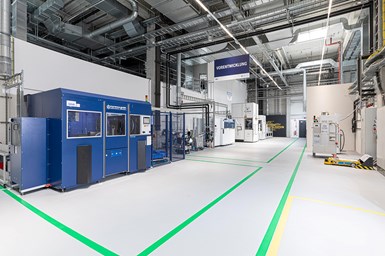Consortium Sets Up Cost-Effective AM Production Lines for Automotive Parts
Automotive parts can now be mass produced using additive manufacturing technology’s laser powder bed fusion for the standard production of cars at two BMW Group sites.
Share
Read Next
A consortium of 12 project partners has set up two fully automated production lines for the additive series production of automotive parts as part of the Industrialization and Digitization of Additive Manufacturing (IDAM) project. The IDAM project goal was to industrialize and digitize AM to utilize it for the series production of automotive parts.
The project was funded by the German Federal Ministry of Education and Research (BMBF) and led by the BMW Group. Scientists from the RWTH Aachen University Chair Digital Additive Production (DAP) supported the project, particularly in the digital automation of process chains.
After three years of collaboration, the consortium says it has successfully implemented metal 3D printing in the standard production of cars at the BMW Group additive manufacturing (AM) campus in Oberschleißheim. There, a digitally networked, fully automated 3D printing production line has been set up and prepared for automotive series production. Another line is located at GKN Powder Metallurgy in Bonn. Thanks to the new infrastructure, the group says that at least 50,000 components in the same-parts production, and more than 10,000 individual and spare parts can now be cost-efficiently produced at two sites using metallic 3D printing.
The fully automated AM line integrates metallic 3D printing into an automated series process in the automotive industry for the first time and offers a look at the further potential of AM for automotive parts, the consortium says.
At the two BMW Group sites, automotive parts can now be mass produced using AM technology’s laser powder bed fusion (LPBF). In this process, metal powder is melted layer by layer with a laser exactly at the points where the final component will emerge. The advantages are that no specially crafted tools are needed, and the implementation of new design possibilities is more flexible.
The result is a fully automated production line thanks to open vector format (OVF). In just three years, a production line was developed, which performs all necessary work steps via computer-operated control. This means that components can be designed, produced and reworked autonomously. Even the recycling of unused metal powders is automated. Driverless transport systems move raw materials and the final products between individual modules of the production line. The machines are orchestrated by a central control unit, in which all production data of the individual line modules converge.
The Open Vector Format, co-developed by the DAP Chair, is said to make an important contribution to this successful digitization. The consortium says new data format is being used to reliably generate and process manufacturing data for the LPBF process. In IDAM, it is utilized to combine the output of different programs or automated substeps along the process chain across manufacturers and to merge the corresponding data. It is said to thus lay the foundation for the scalable, modular and automatically linked LPBF process chain developed in the project.
To make optimal use of the fully automated process line, the DAP Chair developed software modules for automatic orientation optimization of components. The orientation is said to play an important role in the efficiency, durability and quality of the final component. In addition, in-situ process monitoring and data evaluation were improved by developing AI-based algorithms. Here, too, the OVF was able to support by incorporating metadata.
Related Content
10 Important Developments in Additive Manufacturing Seen at Formnext 2022 (Includes Video)
The leading trade show dedicated to the advance of industrial 3D printing returned to the scale and energy not seen since before the pandemic. More ceramics, fewer supports structures and finding opportunities in wavelengths — these are just some of the AM advances notable at the show this year.
Read MoreHow Norsk Titanium Is Scaling Up AM Production — and Employment — in New York State
New opportunities for part production via the company’s forging-like additive process are coming from the aerospace industry as well as a different sector, the semiconductor industry.
Read MoreDMG MORI: Build Plate “Pucks” Cut Postprocessing Time by 80%
For spinal implants and other small 3D printed parts made through laser powder bed fusion, separate clampable units resting within the build plate provide for easy transfer to a CNC lathe.
Read MoreVulcanForms Is Forging a New Model for Large-Scale Production (and It's More Than 3D Printing)
The MIT spinout leverages proprietary high-power laser powder bed fusion alongside machining in the context of digitized, cost-effective and “maniacally focused” production.
Read MoreRead Next
3D Printing Brings Sustainability, Accessibility to Glass Manufacturing
Australian startup Maple Glass Printing has developed a process for extruding glass into artwork, lab implements and architectural elements. Along the way, the company has also found more efficient ways of recycling this material.
Read More4 Ways the Education and Training Challenge Is Different for Additive Manufacturing
The advance of additive manufacturing means we need more professionals educated in AM technology.
Read MoreAt General Atomics, Do Unmanned Aerial Systems Reveal the Future of Aircraft Manufacturing?
The maker of the Predator and SkyGuardian remote aircraft can implement additive manufacturing more rapidly and widely than the makers of other types of planes. The role of 3D printing in current and future UAS components hints at how far AM can go to save cost and time in aircraft production and design.
Read More























